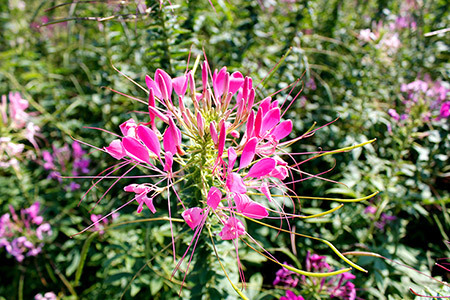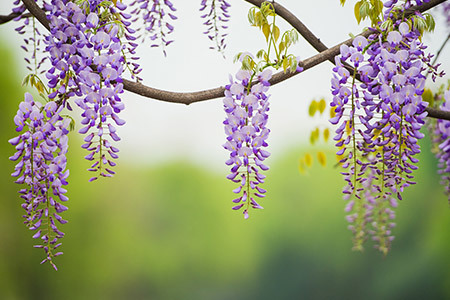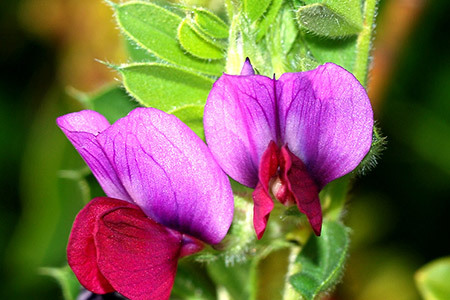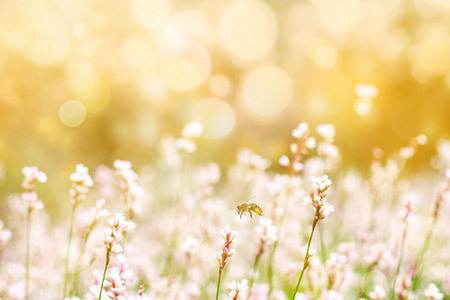Purple clover
A landscaping and flower seed company mainly engaged in the production, sales, and export of flower seeds, tree seeds, forage seeds, green manure seeds, lawn seeds, and medicinal herb seeds.
Classification:
Forage and green manure seeds
Telephone:
Product Description
High-yield Cultivation Technology Regulations for Purple Flower Alfalfa
High-yield and high-quality alfalfa lays the foundation for the benefits of raising dairy cows and other livestock. Lush and dense plants are key to high yields of alfalfa, which requires the correct sowing method, a seedbed conducive to seed germination, and favorable environmental conditions. The key factors determining whether high-density, lush plants can be obtained are: suitable soil pH and fertility, well-prepared seedbeds, adjusting crop rotation sequences to avoid pesticide residue from previous crops, selecting excellent varieties, timely sowing, precision adjustment of sowing machines for sowing rate and depth, and controlling the damage from weeds and pests.
Preparation Before Sowing
1. Site Selection
Sites with the potential for deep root systems are most suitable for planting in deep soil layers, allowing roots to access moisture and nutrients over a large area. In the absence of restrictive layers in the soil, roots can penetrate 4-5 meters underground, thus exhibiting strong drought resistance. Sites with shallow hard layers, rocky layers, or high groundwater levels will restrict root growth and are not suitable for planting. The planting site must have no restrictive layers below 0.9-1 meter from the surface. In areas prone to drought, soil depths of less than 0.9 meters make it difficult to ensure sufficient moisture for good growth or plant survival. The requirements for soil texture are relatively broad, with medium-textured soils such as loam, silt loam, and sandy loam being the best; light soils like coarse sand are prone to drought and are not suitable for planting unless irrigation conditions are available; heavy soils like clay often have too high moisture content, which is detrimental to healthy root growth. Stones on the surface of the soil can be cleared away or buried underground during initial planting. The surface of the planting area must be relatively flat and well-drained. Only on well-drained soils can the highest yields and sustainable use be achieved. Planting on poorly drained soils leads to poor durability, as pathogens causing root rot thrive in wet soils, leading to continuous plant death. Roots are sensitive to anaerobic conditions; when the soil reaches maximum field capacity or is flooded for a certain period, the plants will die. Generally, a drainage ditch 1 meter deep should be dug every 80 meters to ensure timely drainage of standing water. The drainage capacity of the soil below the surface layer varies; gray and mottled soils have poor drainage, while brown or red soils have good drainage.
2. Improving Soil with Lime and Fertilizers
Lime and fertility adjustment: Determining the amount of fertilizer based on soil test results is an important step in planting high-yield and long-lasting crops. Fertilization plans should be developed based on soil pH, soil fertility, and planting history. Soil samples should be taken from the tillage layer to represent the seedbed conditions. Soil acidity is a significant limiting factor for high yields, as it affects nutrient absorption. Applying lime can adjust soil acidity and provide calcium or magnesium. A suitable pH (6.5-7.0) not only enhances the absorption of nutrient elements and promotes the growth of beneficial microorganisms but also reduces the harm from harmful elements like aluminum and manganese. It is best to apply lime and till it into the soil 6-12 months before sowing.
Before sowing, apply sufficient farmyard manure as a base fertilizer, 1.5 tons per acre; if farmyard manure is insufficient, apply 20 kg per acre of affordable fertilizer, or use specialized fertilizers at 45-55 kg per acre.
Before sowing, apply sufficient farmyard manure as a base fertilizer, 1.5 tons per acre; if farmyard manure is insufficient, apply a certain amount of compound fertilizer, 15-20 kg per acre, or use specialized fertilizers at 45-55 kg per acre.
For pH values of 4.5-5.0, apply 150 kg of lime per acre; for pH values of 5.0-5.5, apply 120 kg of lime per acre; for pH values of 5.5-6.0, apply 80 kg of lime per acre; for pH values of 6.0-6.5, apply 50 kg of lime per acre; applying manure or chemical fertilizers before planting can improve soil fertility. The phosphorus content level has the greatest impact on seedlings; in soils low in phosphorus, applying phosphorus fertilizer can promote rapid root growth and successful establishment of seedlings. Seedlings have relatively low nutrient requirements, but nutrients are crucial for high yields and regeneration of well-established crops. Direct contact between seeds and chemical fertilizers should be avoided as much as possible to prevent affecting seed germination.
When soil nitrogen content is low (below 15 ppm) or organic matter content is below 1.5%, nitrogen fertilizer can be applied during planting to increase yield. When soil nitrogen content is above 15 ppm and the soil environment is suitable for root nodule nitrogen fixation (soil pH 6.2-7.5 and rich in nitrogen-fixing bacteria), using nitrogen fertilizer as a base fertilizer not only fails to increase yield but also inhibits the growth of root nodule bacteria, affecting nitrogen fixation.
3. Weed Control
Weed control plans during the seedling stage should be developed and implemented before sowing. When formulating control measures, consider the residual effects of herbicides used on previous crops. For example, if the previous crop was corn, there may be issues with residual triazine herbicides during planting; applying lime before sowing may exacerbate the harm from residual herbicides.
Weed control is a critical step in spring planting; competition from abundant weeds and dry, hot conditions make successful establishment difficult without weed control measures. In the fall, there are relatively fewer weeds when planting alfalfa. Traditional tillage and sowing should use pre-emergent herbicides to control weed competition before planting; if weeds still exist after emergence, post-emergent herbicides need to be applied.
In Henan, it is advisable to choose to sow alfalfa in the fall (before September 10), leveling the land and then sealing it once; if weeds are severe during the seedling stage, the herbicide for alfalfa can be used for weed control.
4. Alfalfa Autotoxicity
4 .苜蓿自毒性
In areas where the soil is suitable for planting alfalfa and is well-managed, alfalfa can be utilized for 5 years, and sometimes even 7 to 10 years can maintain a certain yield. It is best not to sow alfalfa immediately after harvesting old alfalfa, as it can produce harmful chemicals that can harm the newly sprouted seedlings. If alfalfa is continuously planted or the interval between plantings is too short, the survival rate of the newly planted alfalfa is relatively low. Even if the plants survive and grow, although they may appear fine, the yield will continue to decrease in the later stages. This is because alfalfa has self-toxicity; increasing the density of alfalfa through re-sowing is difficult to succeed, as existing plants will inhibit the germination of seeds and the growth of seedlings within a radius of 20 cm around them. In other words, if the alfalfa density reaches 8 plants per square meter, the seedlings in the entire plot will be suppressed. Research shows that a one-year rotation interval for alfalfa in the same plot is sufficient.
5. Variety Selection
Choosing the right alfalfa variety is very important, as it will affect the yield throughout the entire production cycle of alfalfa. In a specific area, many alfalfa varieties may perform similarly, making it difficult to make a clear choice. The choice of variety should depend on one's own situation and the conditions of different plots. Seed price is often a major consideration when selecting varieties. However, the long-term use of cheaper old varieties can be more costly than using slightly more expensive improved new varieties. The improved characteristics of new varieties can bring higher value returns to enterprises. When spreading the planting costs over each production year, the utilization period is the primary factor to consider when selecting varieties.
It is important to choose high-quality seeds, and one should try to select seeds with high purity and superior quality. Many new varieties perform better in terms of yield, disease resistance, and pest resistance compared to older varieties with lower prices, leading to higher economic benefits from planting. Alfalfa varieties should be selected based on the planting location and intended use; some varieties are suitable for hay production, some for grazing, and others for dual purposes.
Alfalfa is classified into autumn dormancy levels, with varieties rated 1-3 having good wintering performance, suitable for planting in northern regions, while varieties rated 8-9 do not enter dormancy in winter and are only suitable for planting in warmer southern regions.
Disease resistance is also an important reference indicator when selecting alfalfa varieties. Only varieties resistant to root rot diseases (such as Phytophthora root rot) can be planted in poorly drained or occasionally flooded plots, as these plots often suffer from more severe diseases than well-drained ones.
II. Sowing Guidance
1. Timely Sowing
The two most suitable times for sowing alfalfa are spring and autumn, but there are significant regional differences, and the best sowing time should be determined based on local specific conditions. In cooler climates, spring sowing is generally adopted, but if sowing is too early, the cool, moist soil can lead to low germination rates, seedling death due to fungal diseases, and weak seedlings. On the other hand, if spring sowing is too late, it can easily lead to failure due to high temperatures, drought, and competition from weeds.
In warmer climates, sowing in late summer is preferable, as alfalfa seedlings can grow in a cooler environment. The benefits of sowing in late summer to early autumn include less competition from weeds, reducing the workload during the busy spring farming season, drier soil that is less prone to compaction, and a lower incidence of wilt disease. When sowing in late summer to early autumn, two points need to be noted: first, sufficient moisture is required; second, there must be enough accumulated temperature before frost arrives. Therefore, the latest sowing time should be 6 weeks before lethal frost. This means that in northern regions, sowing should be completed before August, while in some southern and southwestern areas, sowing can be delayed until November.
2. Sowing Depth
Alfalfa seeds have small cotyledons and very little energy for germination, so the appropriate sowing depth is crucial, generally 1.5-2.0 cm deep with a row spacing of 15-20 cm. A firm seedbed helps achieve moderate sowing depth and ensures that seeds are in good contact with the soil, which is key to successful sowing. Seeds should be covered with enough soil to provide the moisture needed for germination, but not so deep that the seedlings cannot emerge.
3. Seed and Soil Contact
Alfalfa seeds must absorb water equivalent to their own weight to initiate germination, and moisture generally enters the seeds from the surrounding soil. Sufficient contact between seeds and soil ensures that seeds can quickly obtain moisture. If the soil condition (too many clods or too loose) prevents close contact between seeds and soil, the germination time is often prolonged and uneven.
After sowing, pressing can enhance the contact between seeds and soil.
4. Sowing Rate
It is normal for less than one-third of the sown seeds to germinate, and generally, half of the seedlings remain after one year. In most areas of our country, the sowing rate is about 1.5 kg per mu, but for coated seeds, the sowing rate can be increased to 2.0 kg per mu.
III. Sowing Methods
Depending on the different soil cultivation methods, sowing can generally be divided into tilled sowing and no-till sowing.
1. Tilled Sowing
Before sowing, the land must be plowed. The purpose of plowing the soil is to loosen it, remove plant residue, incorporate surface weed seeds into the soil, mix the soil with lime or fertilizer, and prepare a flat surface for future harvesting. Plowing helps lime and fertilizer act on the root zone of alfalfa, facilitating quick emergence and allowing pre-emergence herbicides to work effectively to reduce weed damage. The prepared seedbed should be sufficiently level to facilitate multiple field operations by harvesters and other machinery each year. After the last raking, a roller or round roller can be used to ensure the surface is firm and flat. An adult walking on the seedbed can determine whether the hardness of the seedbed is appropriate. A sufficiently firm seedbed will leave an adult's footprint about 2.5 cm deep. A seedbed that is too loose will lead to sowing too deep, while a seedbed that is too firm or has overly large soil particles will make it difficult for seeds to make sufficient contact with the soil, which is not conducive to seed germination.
2. Furrow Pressing Sowing
2.开沟镇压播种
The ridge-pressing seeder in Kaigou Town has two sets of wavy rollers, with the seed box in between them. The first set of rollers creates wave-like small grooves, followed by the seed box dispensing seeds. The second roller then rolls over to cover the seeds with soil and compact the soil around the seeds. This type of seeder is easy to control the sowing depth and ensures sufficient contact between the soil and seeds. For many years, this seeder has been primarily used for sowing alfalfa on tilled land.
I. Principles of Site Selection
1. Choose land that is elevated, relatively flat, well-drained, with deep and fertile soil, conducive to high-quality and high-yield grass.
2. The grassroots organization team should be united, with a strong awareness of technology among the masses, and in rural areas with an urgent need for mechanization.
3. Suitable for mechanized operations, with convenient transportation. Not suitable for
choosing compact, heavy clay, saline-alkali, overly wet soils, and areas with high groundwater levels and poor drainage, with a salt content of less than 0.3%.
II. Pre-sowing Preparation
1. Land Preparation
Focus on cleaning the ground (weeding, killing stubble), mixing the soil and fertilizer evenly, and leveling the ground. The soil moisture should be around 20%. If the soil moisture is poor, it should be irrigated once thoroughly before land preparation. At the same time, deep application of base fertilizer is necessary; during the planting year, excessive application of top dressing is not advisable. It can be combined with land preparation as base fertilizer, with a fertilization amount of 225 kg/hm2. When sowing in soil with many weeds, first eliminate the weeds, then deep plow, and then spray Fluazifop while mixing the soil to a depth of 5 cm. Sow after 7 days. The main procedures for land preparation are: heavy harrowing to kill stubble, fertilization → deep plowing → light harrowing to level the ground → compaction.
2. Seed Variety Selection and Treatment
Choose high-yielding and disease-resistant varieties such as American alfalfa, with a clover content not exceeding 2%, purity above 95%, and germination rate above 90%.
III. Sowing
1. Selection of Sowing Time
Alfalfa can be sown in spring, summer, and autumn. In Beijing, spring is dry with little rain, making late summer to early autumn suitable for sowing. At this time, sowing has good seedling emergence, low cost, and easy management. Autumn sowing should be done early. If irrigation conditions are available, sowing can also be done in spring when the soil temperature is stable above 5°C, but weed control is necessary. Summer sowing leads to quick seedling emergence, and attention should be paid to weed and pest control.
2. Sowing Method
To facilitate weeding, fertilization, and irrigation, strip sowing is generally adopted, using a 2BJ F-9 precision seeder or a modified grain seeder. During sowing, 30 kg of compound fertilizer can be applied per hectare.
(1) Row spacing: 15-20 cm.
(2) Sowing rate: 1.5-2.0 kg per mu.
(3) Sowing depth: 0.5-2 cm; for clay soils, it should be slightly shallower, and for sandy soils, it can be slightly deeper.
(4) Compaction should be done promptly after sowing.
IV. Field Management
1. Weed Control:
During the growth period of alfalfa, timely weeding and tilling should be carried out. In the first year, seedlings grow slowly and are easily harmed by weeds, so special attention should be paid to weeding during this period.
2. Irrigation and Drainage:
During dry weather, timely irrigation is necessary, generally during the greening period and after each harvest. However, excessive irrigation or muddy water during the seedling stage is detrimental to seedlings. Alfalfa is not tolerant to waterlogging, and any standing water in the soil must be drained promptly.
3. Pest and Disease Control:
Pests mainly include aphids, ants, and parasitic dodder. Generally, chemical control and early harvesting are used to manage pests, but the fundamental control is to choose disease-resistant and pest-resistant varieties.
Key words:
Immediate consultation
If you are interested in our products, please leave your email, we will contact you as soon as possible, thank you!
Product recommend
RELATED INFORMATION
02
/
12
News dynamics
01
/
30
News dynamics
07
/
17
News dynamics
04
/
18
News dynamics
01
/
19
News dynamics
Urban greening is an important component of urban construction.







